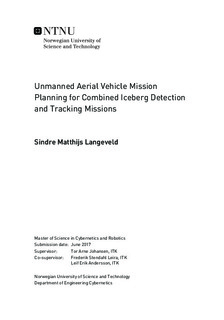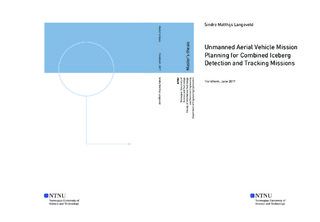| dc.description.abstract | In this master thesis, iceberg detection and tracking by Unmanned Aerial Vehicles has been studied. Currently, most systems for ice management separate these two tasks. However, combining these tasks into a single algorithm might only require one UAV, which could reduce the operating costs. In this thesis, we propose a combined search and track algorithm and investigate its performance and viability.
To test the algorithm, a simulator has been developed. A Kalman filter has been used to keep track of detected
icebergs. Data from wind and ocean currents have been used to determine
critical areas that should be searched. Optimal paths for combined search and
track missions for an Unmanned Aerial Vehicle (UAV), have been computed by
solving a Travelling Salesman Problem. To create a more realistic simulation
environment, an iceberg drift model has been developed. By collecting real
wind and ocean current data from the test area, the model generates dynamic icebergs,
which can be used to test the algorithm. A series of simulations were done to test the algorithm's performance and robustness.
The results indicated that the combined algorithm had the desired behaviour, in the sense that both search and tracking were prioritized in the UAV missions. Further, we found that an iceberg that is being tracked, should be rediscovered as often as possible, in order to optimize the tracking performance. Other tests indicated that the total search radius was decreased when the ice density was increased. The algorithm showed acceptable performance up to an ice density of 50 icebergs. Considering the decreasing search radius, it was concluded that ice densities above this quantity, could lead to an inadequate detection of icebergs. The algorithm's robustness was also tested in a more rapid changing weather condition. This resulted in a degraded total performance, but it was concluded that the likelihood of weather changing this fast and random, was low. The system showed good flexibility when including radar and satellite data. For the radar case, a safer system was obtained. For the satellite case, results indicated that the performance was improved as long as the iceberg classification accuracy was above 75\%.
The results of this study support the viability of a combined search and track algorithm for UAV search and track missions. However, some issues have still to be solved, for instance when it comes to performance in rapidly changing weather. Future work should therefore focus on making the algorithm more robust, before performing experiments with a UAV for proof of concept. | |

